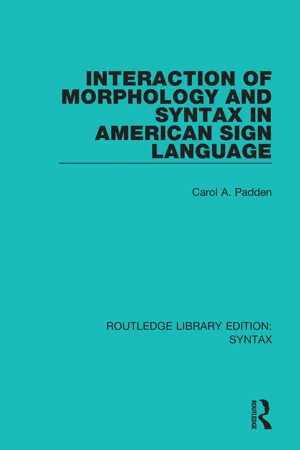Languages & Linguistics
Subject Verb Agreement
Subject-verb agreement refers to the grammatical rule that a subject must agree with its corresponding verb in number (singular or plural). This means that a singular subject takes a singular verb, and a plural subject takes a plural verb. Maintaining subject-verb agreement is essential for clear and effective communication in writing and speech.
Written by Perlego with AI-assistance
Related key terms
5 Key excerpts on "Subject Verb Agreement"
- eBook - ePub
- Constance Immel, Florence Sacks(Authors)
- 1999(Publication Date)
- RWW Career Press(Publisher)
Chapter 7Agreement
7.1 Subjects and Verbs
Identifying the subject and the verb is the first step in correcting subject-verb agreement errors. The verb agrees in person and number with its subject. The subject and the verb must agree in number.A singular subject (one person or thing) takes a singular verb.The bird sings. The wheel turns. The student reads.A plural subject (more than one person or thing) takes a plural verb.The birds sing. The wheels turn. The students read.From these examples, or from a review of verb endings in Chapter 2 , it should be clear that the singular verb in the present tense ends in -s .A subject and a verb agree if you use the correct form of the verb with the subject. Add an -s to the singular verb in the present tense when the subject is he , she , or it , or a singular noun which can be replaced by he , she , or it .In order to be sure that the verb agrees with the subject, mentally change the noun subject into a pronoun and then select the correct form of the verb. Examples:1. Bill walks to work. (Mentally change the subject Bill to he .) He walks to work.2. Sarah drives a car. (Mentally change the subject Sarah to she .) She drives a car.3. This pencil needs to be sharpened. (Mentally change the subject pencil to it .) It needs to be sharpened.4. The tennis players run after the balls. (Mentally change the subject tennis players to they .) They run after the balls.Again, notice that for singular verb form (the one with he , she , or it ) you add an -s to the end of the verb in sentences 1, 2, and 3. In sentence 4, -s is not added to the verb run because the subject tennis players is plural.Exercise 7.1
Rewrite each of the following sentences, making the subjects and the verbs singular. Some sentences may require the addition of a modifier, such as a or the . Keep all verbs in the present tense.1 . Palm trees give little shade.2 . The students like the Spanish class.3 . Old photographs are faded.4 . The bus drivers collect our fares.5 - eBook - ePub
- Robert Hollander(Author)
- 2012(Publication Date)
- Dover Publications(Publisher)
grammatical errors. We ourselves may feel licensed to break the rules and, as long as we do so convincingly and with knowledge, we can usually persuade our reader or listener that we are behaving reasonably. If so, not only will we be able to get away with a solecism, we may even be admired for it; those who really understand the rules may break them with impunity. This section is mainly concerned with various kinds of solecism.AGREEMENT: PERSON, NUMBER, CASE, AND GENDERFailure to preserve grammatical agreement is perhaps the main source of misspeaking and faulty writing in English. The word agreement is used here in a technical sense: All related grammatical elements in a sentence must agree with one another.A verb must agree with its subject (agreement of person).I think, therefore I am.not I think, therefore I is.There are occasional anomalies even with this simplest of rules.William and Mary are friends.but William & Mary is a college.An adjective must agree in number with the noun it modifies.A person should keep his [or her or his or her] options open.not A person should keep their options open.A noun and a pronoun must reflect each other’s gender.All my men are out on their patrols.not All my men are out on his or her patrols.and not Each of my men is out on his or her patrol.Pronouns must reflect their case.The teacher whom I likenot The teacher who I likeLatin had a highly developed system of cases with specially inflected endings. Every noun, pronoun, and adjective had five major cases (nominative, genitive, dative, accusative, and ablative) as well as two minor ones (vocative and locative). Although the English system is simpler, it has cases, too— the subjective, possessive, and objective .The subjective case (corresponding to the Latin nominative) is used for the subject of a sentence or a clause, or for a word standing grammatically in the subject’s place, even if that word appears in the predicate of the sentence.Bob, my uncle, is a teacher.Bob, uncle and teacher are all in the subjective case and all describe the same person. The word uncle is in apposition to Bob, as both are in the subject’s part of the sentence; teacher is a predicate noun - Carol A. Padden(Author)
- 2016(Publication Date)
- Routledge(Publisher)
Chapter 6Verb AgreementThis chapter is concerned with the statement of the verb agreement rule in clauses like (1-2) below in which agreement is determined by the subject and notional direct object, but in (3-4), the subject and notional indirect object.- (1) GIRLi HATEj BOY.'The girl hates the boy.'
- (2) DOGi RITEj CAT."The dog bit the cat.'
- (4) SISTERi HOW1 PAPER.'My sister showed me the paper.'
The structures proposed for sentences like (1) and (3) bear on the statement of the verb agreement rule. Friedman (1975) proposed that the form of agreement morphology could be predicted from the "source" and "goal" of the clause, as in (5) below. Since the notions of source and goal have been proposed elsewhere (Fillmore 1971, Jackendoff 1972, Gruber 1978) for "verbs of motion", at first appearance, they seemed particularly apt for the description of a class of verbs in ASL. Under Friedman's (1975) analysis, the direction of the linear movement in verbs was described as originating at the locus position of the source nominal of the sentence and moving toward the locus position of the goal.- (5) Source-Goal Analysis: Verb AgreementThe initial point of the directional verb marks for person and number of the source and the end point, the goal.
5.1 presented several arguments against stating the agreement rule in terms of "source". While it appeared that the notion of "source" captured certain generalities about verb morphology, the same benefit failed to appear elsewhere in the grammar. From the data on agreement marker omission and the co-referentiality constraint in FORCE-type complement structures, it can be seen that stating these rules in terms of "source" resulted in statements which were less general than if stated in terms of "subject."Kegl (1978) suggested that sentences like (3-4) are "advancement structures" in which the "initial" indirect object advances to "final" direct object. Under this analysis, the verb agreement rule is stated in terms of grammatical relations and levels of syntactic representation, shown below in (6):- Josep Quer, Roland Pfau, Annika Herrmann(Authors)
- 2021(Publication Date)
- Routledge(Publisher)
Table 5.1 summarizes the possibilities.Table 5.1 Classification of verbs according to their agreement possibilitiesClass Subclass Main exponent Inflecting Agreement verbs Regular Subject to object path movement Backwards Object to subject path movement Spatial verbs Source to goal path movement / Location Non-inflecting Plain verbs Potential agreement with a single location 5.2.3 Agreement auxiliaries
For some sign languages, an auxiliary predicate has been described that encodes the agreement relations of the lexical predicate it co-occurs with. Unlike typical spoken language auxiliaries, the ones instantiated in sign languages encode subject and object agreement, but not categories such as tense or mood, although in some sign languages some aspectual categories can be conveyed by the agreement auxiliary as well. In general, they combine with lexical plain verbs that do not carry agreement morphology, as illustrated in (11) from Argentine Sign Language (LSA), although they can co-occur with agreement verbs (inflected or uninflected) under special circumstances (e.g., emphasis), as well as with backwards agreement verbs. It is important to note that in the latter case the movement path of the auxiliary is the regular one from subject to object locations, namely in the opposite direction to the one of the lexical backwards verb, as exemplified in (12) from LSC.- David Hornsby(Author)
- 2014(Publication Date)
- Teach Yourself(Publisher)
to be, mark subject–verb agreement only for the third person singular of the present tense. But many other languages have rich and complex agreement systems. Hungarian verbs, for example, not only mark agreement with a subject but also indicate whether a direct object is definite or indefinite (data from Corbett 2006: 92):• Egy könyv-et olvas-naka book-acc read-3pl-indefThey are reading a book• Egy könyv-et olvas-sáka book-acc read-3pl-defNote how the verbal suffix (in bold) changes when the object is definite.They are reading the bookA distinction needs to be drawn here between agreement and government (or rection). The difference can be illustrated with examples from Spanish:1 El libro pequeño The small book2 Los libros pequeños The small books3 La casa pequeña The small house4 Las casas pequeñas The small housesIn each case, the article and adjective are inflected for gender (masculine/feminine) and number (singular/plural). For number, this is a case of agreement: we are free to select either singular (1 and 3) or plural (2 and 4) for each noun phrase, and the noun and modifiers must be marked for the same number value. For gender, however, the values ‘masculine’ or ‘feminine’ are not a matter of choice: the value for this category is a fixed part of the lexical specification for Spanish nouns, which is then imposed on the modifiers. The noun is therefore said to govern the adjective for gender in Spanish. In similar vein, Latin verbs and prepositions were said to govern nouns for case: the preposition in (‘in’) governed ablative case when it referred to position, but accusative case when it indicated movement:• Caesar in urbe (abl) habitat Caesar lives in the city (Location)• Caesar in urbem (acc) ambulat Caesar walks into the city (Direction)Both types of government involve inherent properties of the governing items, which have to be specified in the lexicon. In other words, a Spanish native speaker ‘knows’, albeit not necessarily in a conscious sense, that libro governs adjectives and determiners for masculine gender, just as speakers of Latin ‘knew’ that the preposition in
Index pages curate the most relevant extracts from our library of academic textbooks. They’ve been created using an in-house natural language model (NLM), each adding context and meaning to key research topics.




